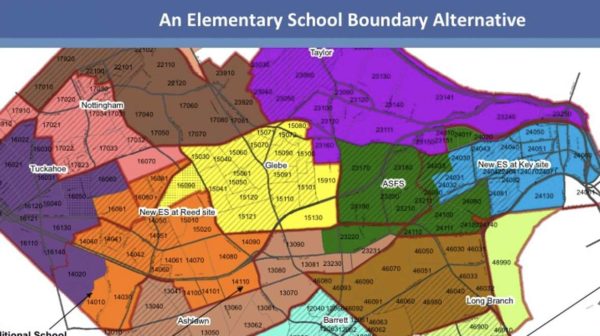 Peter’s Take is a biweekly opinion column. The views expressed are solely the author’s.
Peter’s Take is a biweekly opinion column. The views expressed are solely the author’s.
APS continues its record of flawed planning with the 2020 Elementary School Boundary Process. The latest recommendations typify years of ineffectual boundary planning.
In 2018, APS recognized it had a problem: a mis-match of the geographic locations in which its elementary students resided and the locations of schools. Further, APS identified the planning corridors (Rosslyn-Ballston, Columbia Pike, and Route 1) as the locus of the future enrollment growth, but the next new facility — Reed — was not being constructed where seats were needed. Therefore, APS began internal deliberations to adjust county-wide elementary school boundaries (for school year 2021-22).
The objectives included:
- create Reed and Science Focus (ASFS) attendance zones
- address overcapacity at schools
- maximize building capacity
- make efficient use of existing facilities and resources
- adhere to walk zones and balance demographics when possible
Last February the School Board voted to move Key Immersion to ATS, ATS to McKinley, and McKinley to Reed. Although this was and remains very controversial, the net result moved Option programs closer to areas with excess seats and freed up neighborhood seats at the Key site. However, because APS decided to limit additional stress during the pandemic, it hastily decided to abandon a first principle of any boundary process–to balance enrollment.
APS objectively has defined “preferred maximum” numbers of students at each school using Virginia guidelines. But APS has ignored its own analysis and excluded schools like Abingdon. Abingdon is projected to reach 930 students in 2022-23 with a preferred maximum of only 742. Other schools like ASFS, with a preferred maximum of 637 students, are included, yet ASFS is projected to enroll 662 in 2022-23 with the strong potential that up to an additional 80 will enroll if they elect not to move with Key Immersion. Others like Dr. Charles Drew–adjacent to Abingdon–has approximately 400 preferred maximum unfilled seats. And schools like Ashlawn and Tuckahoe (in this boundary process) have 200+ combined preferred maximum seats available through 2022-23.
The “minimal” boundary changes now proposed are unfair
Even for the small number of schools involved, APS’s latest proposal does not maximize flexibility nor does the proposal minimize impact on families as a foundation for the 2022 process. APS proposes moving several planning units from Ashlawn to ASFS even though future flexibility is needed there. At the same time APS proposes moving some students from McKinley to Ashlawn. These moves should be delayed until 2022 to preserve flexibility. Finally, APS leaves Tuckahoe well under-capacity. APS should use Tuckahoe’s excess seats to balance capacity from Ashlawn along the southwestern boundary of the County where future flexibility is less important.







